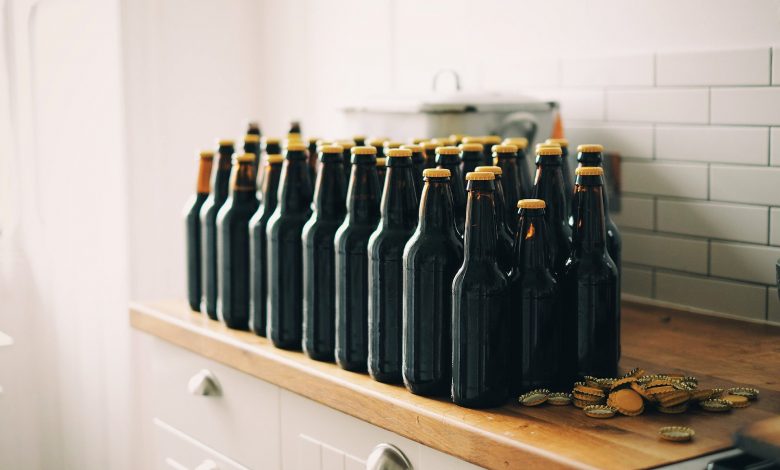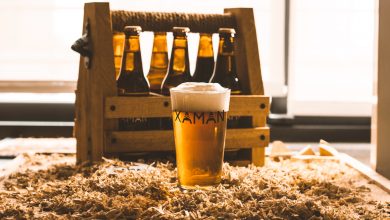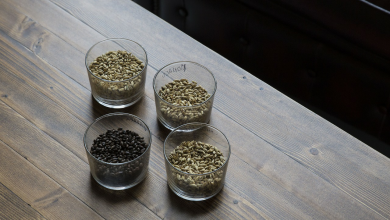Helium Beer: Is It Real?

On April 1, 2014, beer fanatics believed the reign of carbon dioxide in beer fermentation was over, and helium was the newly crowned king-ingredient in beer production. After all, if nitrogen could substitute for carbon dioxide in Guinness beer, why couldn’t helium do the same?
Stone Brewing and Boston Beer Co. introduced this belief in the minds of many beer lovers as fast as it would take them to brew a beer with the Norwegian yeast. Consequently, the internet went agog with the announcement of the newest beer in view. Every beer enthusiast wanted to be the first to lend credence to the existence of helium beer. Moreover, there were numerous demands and inquiries about this enigmatic beer giving its drinker high-pitched voice as a reaction for taking a pint of it.
This entire buzz only brought about one burning question for the curious-minded: Is helium beer real? Trust us to have the answer to this question.
Is Helium Beer Real?
Based on science, helium is insoluble in water. Therefore, it shares the same fate in beer. Luckily, you can carbonate nitrogen and carbon dioxide in beer.
Infusing liquid helium into beer isn’t achievable either because it changes from liquid to gas at -220 degrees Fahrenheit. So you’d have frozen alcohol. However, if you manage to infuse the liquid element into your brew successfully, it’d only surge due to its insoluble characteristic, and you’ll end up spilling your beer.
But then, as a beer-lover, you wouldn’t want to go against scientific logic only to lose your precious beer in the process of exploring, would you?
How to Make Helium-Infused Beer?
A little disappointment might be coming to you in the following sentence if you’re a helium beer optimist. The truth is, there’s no way in a state-of-the-art brewery you can infuse helium in beer. This reality is because the chemical element is unapologetically insoluble in beer and not even adding pressure can help with its fate.
Contrary to carbon dioxide and nitrogen, helium takes off as you uncork your beer jar. What’s worse? It pours the beer along as it makes it out of the container. So no brewer would take their time to brew batches of beer only for helium to make a mess of it.
Where to Purchase Helium-Infused Beer
You might think Stone Brewing and Boston Beer Co. would be kind enough to satiate helium beer optimists with this beer after all, but sadly, their intention was no purer than being a participant of an April fool prank. We should state categorically that you can’t purchase helium beer anywhere in the world because science forbids it. Consider this:
Helium and High-Pitched Voice
No beer has the power to lend its drinkers a high-pitched voice unless we’re talking slurry words and speeches when a drinker succumbs to an advanced state of inebriation. Helium beer doesn’t exist, so there’s no way a high-pitched voice would emanate from drinking the normal beer.
Good thing you now know that there’s no truth to the existence of this beer, so let’s tell you what we found out during our research.

Other Pranks Stone Brewery Have Pulled on Beer Aficionados
From our study of Stone Brewery, we gathered that the company isn’t new to sending her fans and beers lovers alike into a frenzy over a hoax every April 1st. More interestingly is the fact that this behavior has become a proud culture of the company ever since it took the first leap in the year 2002. You’d agree it must be an enjoyable sight to watch fans go crazy over a nominal beer.
How Stone Brewery Played Us
For the first year, the fun-loving brewery made its prank about “stone extreme lemony-lime.” After a swell time of watching their devotees go inquisitive, the company went “stone monolith” in the subsequent year. For 2004, the brewery decided to give a false sense of seriousness to the stunt by fast-tracking the process much earlier than April 1st of the same year. So it came up with “stone justification ale” which fulfilled the aim of the announcement.
However, they weren’t about to relent quickly, as there was more for the coming years. Considering that stimulants such as caffeine were the in-thing in 2006, the company decided to play along. Thus, they pseudo-released a “bastard oxide energy ale.” You guessed right; beer lovers still fell flatly for the trick. You may blame that on our insatiable beer palates.
After that, the company came up with an even more bizarre theme for its 2009 prank. Ever heard of a black pilsner? Well, Stone Brewery made that up in the said year. Curiosity heightened again; hence it was a hit.
The company played a few more April fool stunts but held their peace since 2016.
Now let’s talk about the actual inert gases present in your favorite beer, carbon dioxide and nitrogen.
Bubbles in Your Beer
Carbon dioxide isn’t in your beer just because it can. The chemical compound is very much valuable when it comes to the exciting appearance beers exude, whether in a mug or bottle.
Without carbon dioxide, there’ll be no carbonated beer. Thus, the more carbon dioxide you have in your brew, the more carbonated it gets. Let’s not forget that it’s the reason for the jolly bubbles atop your beer. So it’s not something we can do without, unlike helium.
Furthermore, the carbonation of beer is a two-way thing, natural or force carbonation.
Natural Carbonation
Natural carbonation happens during the fermentation stage of beer. CO2 is liable to escape during this stage. Thus, to enable the beer to remain carbonated, homebrewers store the brew in a container right before completing the fermentation process.
In the course of fermenting the beer, yeast sucks up the sugar present in the wort. After this, there’s the release of carbon dioxide and alcohol, which signifies the primary fermentation process. For some brewers, they’d instead increase the beer’s sugar level during this process. This action, however, births secondary fermentation, otherwise known as bottling conditioning.
Besides, immediately after the initial fermentation, the yeast yet again absorbs the extra sugar. Hence, fermentation occurs again and generates a desirable degree of carbon dioxide. At this point, the beer becomes alcoholic.
It’s worth noting that wrong bottle conditioning is responsible for beer flatness.

Force Carbonation of Beer
By force-carbing, you’re cutting time and heading directly to the moment when you’ll have to sip your tasty beer. The process involves adding carbon dioxide to your beer straight from a gas cylinder while maintaining stable pressure.
Of course, to do this, you’ll need a gas cylinder stocked with carbon dioxide. A gas regulator, along with your keg kit should also be on standby. A quick connector spear of your choice (double or single) would also be useful to conduct force carbonation.
Also, you can force-carb your beers in two ways. One method involves reducing the CO2 pressure while carbonating for a relatively lengthier time, while the second method would require more struggle; however, it’ll have your beer ready at a much faster time.
The Distinction in the Speed Between Natural and Force Carbonation
Bottle conditioning requires the brewer to exercise patience for several weeks to produce a carbonated beer. Let’s hope your appetite wouldn’t die off before then. Besides, naturally-carbonated beer doesn’t last long on the shelf due to the presence of yeast in it.
On the other hand, the discovery of force carbonation has reduced the time it takes to produce a carbonated beer. In a matter of hours, carbonation is sure to take place. However, this method requires more carbon dioxide gas. It’s also a standard technique among homebrewers and craft brewers.
The Difference in Appearance Between Natural and Force-Carbonated Beer
Without carbon dioxide, beer would be flat and dull, but its presence creates the foams atop of the brew. Therefore, the more carbon dioxide is available, the more visible the foams will be. So for natural carbonation of beer, which requires lesser CO2, there are lesser bubbles which are equally smaller. Contrarily, force-carbonation produces more bubbles that are also bigger.
Nitrogenated Beer
Nitrogenated beer exists because nitrogen is soluble in beer. More so, both nitrogen and carbon dioxide blend well. The combination of these gases amounts to 70 percent nitrogen and 30 percent carbon dioxide in beer. Most brewers now produce nitrogenated beer. But we must state that the Irish brewers set the pace to this trend.
Beer enthusiasts can easily spot a nitrogenated beer upon relishing its creamy taste. Its less acidic flavor also gives it away. Nitrogen also has a hand in beer bubbles. More so, its bubbles are quite persistent.
The brewing of nitrogenated beer is at a higher keg pressure. This situation allows the beer to produce tiny bubbles when serving through a restrictor plate, while the same process solely involving CO2 amounts to a bad over-carbonated beer.
It’s necessary to serve a nitrogenated beer at a higher serving-temperature degree, preferably at 40 to 42 degrees Fahrenheit. Guinness stout, who pioneered the use of nitrogen gas, also utilized the preferred temperature in their beer. At this temperature, carbon dioxide solubility is usually low.
Furthermore, the use of the higher serving-temperature by nitrogenated beer births the creamy and delicate flavor beer drinkers enjoy.
Know this and know peace; helium beer is inexistent. You may add carbon dioxide, nitrogen, or both to your beer; however, helium would never work.



